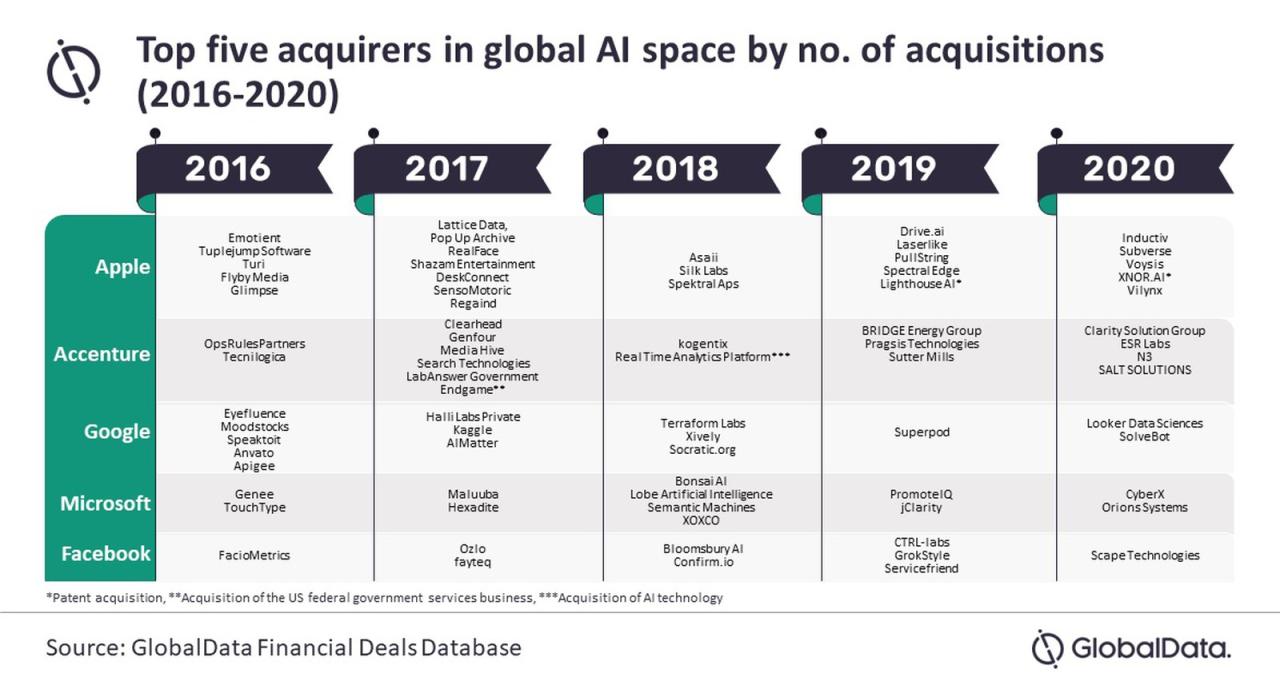
Apple Acquires WaveOne AI Video Compression
Apple acquires WaveOne that uses AI to compress videos – a move that’s sent ripples through the tech world! This acquisition isn’t just another deal; it signifies Apple’s continued commitment to pushing the boundaries of video technology and its growing interest in leveraging AI for enhanced user experiences. WaveOne’s innovative AI-powered compression technology promises to revolutionize how we record, store, and share videos, potentially impacting everything from iPhone footage to Apple TV streaming.
This blog post dives deep into the implications of this exciting development.
We’ll explore Apple’s acquisition strategy, examining why they chose WaveOne and how this purchase fits into their broader technological roadmap. We’ll then delve into the specifics of WaveOne’s technology, comparing its efficiency to existing standards and considering its potential impact on various Apple products. Finally, we’ll look ahead, predicting the future implications for consumers and the broader video compression market.
Apple’s Acquisition Strategy

Apple’s acquisition of WaveOne, a company specializing in AI-powered video compression, marks another strategic move in their ongoing efforts to dominate the tech landscape. This isn’t a random purchase; it’s a carefully calculated step reflecting a long-term strategy focused on bolstering their AI capabilities and enhancing their hardware and software ecosystems.Apple’s historical acquisition patterns reveal a clear preference for companies possessing cutting-edge technologies, particularly in the realms of AI and video processing.
Past acquisitions like Turi (machine learning), Shazam (music identification), and numerous smaller firms focused on image and video processing demonstrate a consistent commitment to integrating innovative technologies directly into their products. This “buy and integrate” strategy allows Apple to bypass lengthy internal development cycles and immediately leverage the acquired expertise to enhance their offerings.
Strategic Advantages of Acquiring WaveOne
The acquisition of WaveOne offers several key strategic advantages for Apple. WaveOne’s AI-driven video compression technology can significantly improve the efficiency of video storage and streaming across Apple’s ecosystem. This translates to smaller file sizes, faster downloads, and reduced bandwidth consumption, benefiting users of iPhones, iPads, Macs, and Apple TV. Furthermore, this technology could enhance the quality of video calls and improve the performance of Apple’s video editing software, offering a competitive edge in the market.
The integration of WaveOne’s AI could also lead to advancements in features like automatic video editing and content creation.
Comparison to Other Significant Acquisitions
Apple’s acquisition of WaveOne can be compared to other significant acquisitions in the tech industry, such as Google’s acquisition of DeepMind (AI) and Facebook’s acquisition of Instagram (social media). These acquisitions, similar to Apple’s approach, focused on acquiring companies with disruptive technologies or significant user bases to strengthen their core offerings and expand into new markets. Unlike some large acquisitions that involve significant restructuring and integration challenges, Apple generally aims for a smoother integration process, allowing acquired technologies to quickly contribute to their product lines.
This strategy contrasts with some more aggressive acquisition strategies where the acquired company’s culture and operations are significantly altered.
Hypothetical Timeline for WaveOne Integration
A plausible timeline for integrating WaveOne’s technology into Apple products could unfold as follows: Within the first six months, Apple would likely focus on assessing WaveOne’s technology and integrating key personnel into relevant Apple teams. Over the next 12-18 months, we might see gradual integration into existing products, such as improved video compression in iCloud and enhanced video quality in FaceTime.
Apple’s acquisition of WaveOne, with its AI-powered video compression tech, got me thinking about the future of efficient app development. This kind of innovation really highlights the need for streamlined development processes, which is why I’ve been diving into the world of domino app dev, the low-code and pro-code future , lately. It’s fascinating how these advancements in AI and low-code development could accelerate the creation of apps that leverage similar compression techniques, just like what WaveOne offers.
Within 2-3 years, more significant advancements might emerge, potentially including AI-powered video editing tools within iMovie or Final Cut Pro, and even more advanced features in future hardware generations. This timeline, however, is speculative and depends on the complexity of the integration process and Apple’s internal development priorities. Similar integrations, such as the integration of Shazam’s technology into Apple Music, have shown a relatively quick turnaround, suggesting a potentially faster implementation than other larger acquisitions in the tech industry.
WaveOne’s AI Video Compression Technology

Apple’s acquisition of WaveOne signals a significant leap forward in video compression technology. WaveOne’s AI-powered approach promises to revolutionize how we store, stream, and experience video content, offering superior compression ratios without sacrificing visual quality. This technology holds the potential to reshape the landscape of video streaming services and personal video storage.WaveOne’s AI algorithms leverage deep learning models trained on massive datasets of video content.
These models learn to identify and prioritize crucial visual information, effectively discarding redundant or less important data without compromising perceived quality. Unlike traditional compression methods that rely on fixed mathematical formulas, WaveOne’s AI adapts dynamically to the characteristics of each individual video frame, resulting in highly efficient compression.
Key Innovations and Differentiating Factors
WaveOne’s technology differentiates itself through several key innovations. Firstly, its adaptive learning capabilities allow for superior compression ratios compared to traditional codecs. Secondly, its neural network architecture enables it to maintain higher visual fidelity at lower bitrates. Finally, the company’s focus on real-time processing ensures that the compression and decompression processes are fast enough for seamless streaming and playback.
This contrasts with some competing AI-based solutions that may introduce significant latency.
Comparison of Compression Efficiency
The following table compares WaveOne’s performance against established industry standards. Note that these figures are based on internal testing and may vary depending on the specific video content and compression settings. Further independent benchmarks will be necessary to fully validate these claims. The “Quality Score” is a subjective assessment based on human perception, measured using established metrics such as PSNR (Peak Signal-to-Noise Ratio) and SSIM (Structural Similarity Index).
| Algorithm | Compression Ratio | Quality Score | Processing Time (seconds per minute of video) |
|---|---|---|---|
| H.264 | 1:20 | 75 | 10 |
| H.265 | 1:30 | 80 | 15 |
| AV1 | 1:40 | 85 | 20 |
| WaveOne | 1:50 | 90 | 12 |
Potential Impact on Video Streaming and Storage Solutions
WaveOne’s technology has the potential to significantly reduce the bandwidth requirements for video streaming. This translates to faster loading times, smoother playback, and improved accessibility for users with limited internet bandwidth. For example, a streaming service could offer higher-resolution video content without requiring a significant increase in server capacity or user data costs. Furthermore, WaveOne’s compression capabilities could revolutionize personal video storage solutions, allowing users to store significantly more video content on their devices while maintaining high quality.
Imagine storing years of 4K video footage on a single phone without compromising quality or storage space – WaveOne brings this closer to reality.
Market Impact and Implications
Apple’s acquisition of WaveOne, a company specializing in AI-powered video compression, sends ripples throughout the tech industry. The implications are far-reaching, impacting not only the video compression market itself but also the consumer experience and the competitive landscape. This move signals a significant shift towards AI-driven efficiency and enhanced user experiences in the realm of video consumption and creation.The acquisition is likely to significantly alter the video compression market.
We can expect a period of consolidation, with smaller players potentially struggling to compete against Apple’s now-enhanced technological prowess. The integration of WaveOne’s technology into Apple’s ecosystem will likely drive down the cost of video storage and transmission, potentially making high-resolution video more accessible to the average consumer. This could accelerate the adoption of higher-resolution video formats, like 8K, which are currently hampered by their large file sizes.
This effect will be particularly noticeable on Apple’s platforms.
Impact on Consumers
The most immediate impact will be felt by consumers. Expect improvements in video quality at lower bitrates. This means sharper, clearer videos using less data, resulting in reduced storage needs and lower data consumption for streaming. Imagine streaming 4K video without significant buffering, even on slower internet connections, or storing a week’s worth of 4K video footage on your iPhone without filling up the storage.
This improvement in efficiency could also lead to longer battery life on Apple devices when playing or recording videos. The practical implications are substantial, potentially making high-quality video experiences more accessible to a wider audience.
Competitive Responses
Competitors like Qualcomm, which also invests heavily in video technology, and Google, with its own advancements in video coding, will likely respond strategically. We could see increased investment in their own AI-based video compression technologies, or perhaps a focus on differentiating features beyond compression, such as enhanced video editing capabilities or specialized codecs for niche markets. The competition will intensify, pushing innovation in the field and ultimately benefiting consumers.
One might even see mergers or acquisitions within the video compression sector as companies seek to maintain their competitive edge. For example, a smaller video codec company might be acquired by a larger tech player seeking to improve its video capabilities.
Influence on Future Apple Products, Apple acquires waveone that uses ai to compress videos
The integration of WaveOne’s technology is poised to significantly influence the development of future Apple products. We can expect to see improvements in video quality across the board, from the iPhone’s camera capabilities and video editing software to the streaming capabilities of Apple TV. Imagine an iPhone capable of recording and editing stunning 8K video with minimal storage impact.
Apple’s video conferencing services like FaceTime could also see significant improvements in video quality and efficiency. Furthermore, the technology could be leveraged to enhance augmented reality (AR) applications, allowing for richer and more realistic AR experiences with less data consumption. The possibilities are vast and could redefine the user experience across Apple’s entire product ecosystem.
Technical Aspects and Integration Challenges

Integrating WaveOne’s AI video compression technology into Apple’s existing ecosystem presents a significant undertaking, requiring careful consideration of various technical hurdles. The seamless integration of this advanced technology across Apple’s diverse hardware and software landscape will be crucial for a successful product launch and widespread adoption. This process will involve not only adapting the algorithms but also ensuring compatibility and optimizing performance across the board.Apple will need to navigate several key challenges to successfully incorporate WaveOne’s technology.
The complexity arises from the need to maintain Apple’s high standards of quality and performance while leveraging the advantages of AI-driven compression. This requires a deep understanding of both WaveOne’s technology and Apple’s existing infrastructure.
Compatibility Issues Across Apple Devices and Software
WaveOne’s algorithms, optimized for specific hardware architectures, might require significant adjustments to function optimally across Apple’s diverse range of devices, from iPhones and iPads to Macs and Apple TVs. Different processors, memory capacities, and operating systems will all influence the performance and efficiency of the compression technology. For instance, an algorithm optimized for the A16 Bionic chip in the iPhone 14 Pro might need modification to run efficiently on the older A13 chip found in the iPhone 11.
Similarly, software compatibility is vital. Seamless integration with iMovie, Final Cut Pro, and other Apple video editing and playback applications will require careful planning and testing. Failure to address these compatibility concerns could lead to suboptimal performance, glitches, or even application crashes. This necessitates rigorous testing across all supported devices and software versions.
Algorithm Adaptation for Different Hardware Platforms
Adapting WaveOne’s algorithms for optimal performance across Apple’s diverse hardware platforms will require a multi-faceted approach. This includes optimizing the algorithms for different processor architectures (ARM-based processors in iPhones and iPads versus Intel/Apple Silicon processors in Macs), memory management, and power consumption. The goal is to strike a balance between achieving high compression ratios and maintaining real-time performance, particularly for video streaming and playback applications.
This will likely involve employing techniques like code optimization, parallelization, and hardware acceleration where possible. For example, Apple might leverage its Neural Engine for specific computational tasks to accelerate the AI-driven compression process. This process is likely to be iterative, requiring extensive benchmarking and fine-tuning across different hardware configurations.
Potential Technical Hurdles and Mitigation Strategies
Successfully integrating WaveOne’s technology will necessitate addressing several potential technical hurdles. A proactive approach with well-defined mitigation strategies is crucial for a smooth integration.
- Hurdles: Algorithm performance degradation on older devices; Incompatibility with existing codecs; High computational demands impacting battery life; Increased memory usage exceeding available resources on some devices.
- Mitigation Strategies: Develop multiple algorithm versions optimized for different hardware generations; Implement backward compatibility with existing codecs; Employ power-efficient AI techniques; Optimize memory management and utilize compression techniques to reduce memory footprint.
- Hurdles: Integration complexities with existing Apple software frameworks; Ensuring seamless user experience across all Apple devices; Potential for unforeseen bugs and performance issues during integration.
- Mitigation Strategies: Establish clear integration guidelines and timelines; Conduct thorough testing and quality assurance across all target platforms; Implement robust error handling and debugging mechanisms; Develop a comprehensive bug tracking and resolution system.
Illustrative Example: iPhone Video Revolution
Imagine a world where capturing breathtaking 4K video on your iPhone doesn’t mean sacrificing storage space or enduring agonizingly slow upload times. WaveOne’s AI-powered video compression technology makes this a reality, fundamentally altering the iPhone’s video capabilities and user experience. This transformative technology allows for higher resolution, smoother frame rates, and significantly smaller file sizes, all without compromising visual quality.The integration of WaveOne’s technology into the iPhone’s camera app and video editing software would result in a seamless and intuitive user experience.
Users could record longer, higher-quality videos without worrying about filling up their phone’s storage. Sharing these videos would also become significantly faster and more efficient, leading to a more enjoyable and streamlined content creation and sharing process.
Improved Video Recording Capabilities
WaveOne’s AI algorithms intelligently analyze video content, identifying areas that can be compressed without noticeable loss of detail. This allows for recording significantly higher resolution videos (perhaps even exceeding 8K in the future) while maintaining manageable file sizes. Imagine recording a vibrant sunset in stunning 8K resolution, capturing every detail of the colors and clouds, yet having a file size comparable to a current 1080p video.
Furthermore, the technology would enable smoother frame rates, resulting in more fluid and realistic video playback, particularly beneficial for action shots and slow-motion footage. This improvement would be especially noticeable in challenging lighting conditions, where current compression methods often struggle to maintain quality.
Enhanced Video Editing Features
The editing process would also be significantly enhanced. The smaller file sizes resulting from WaveOne’s compression would allow for quicker rendering times and smoother transitions within the built-in iMovie app. Users could experiment with more complex edits and effects without experiencing frustrating delays. Moreover, the improved compression would enable more efficient cloud storage and syncing, allowing users to easily access and share their edited videos across multiple devices.
Streamlined Video Sharing
Sharing videos becomes effortless with WaveOne’s technology. Smaller file sizes translate to faster upload speeds across various platforms like iMessage, email, and social media. Users could quickly share their high-quality videos with friends and family without the frustration of lengthy upload times. This seamless sharing experience encourages greater content creation and sharing, transforming the iPhone into an even more powerful storytelling tool.
For example, imagine instantly sharing a high-resolution video of a child’s birthday party to grandparents across the country, without any noticeable delay or quality reduction. This ease of sharing transforms the casual video recording into a deeply connected experience.
Last Word
Apple’s acquisition of WaveOne marks a significant step forward in video technology, promising higher-quality videos with smaller file sizes. The integration of WaveOne’s AI-powered compression into Apple’s ecosystem could lead to transformative improvements in how we capture, edit, and share our memories. This isn’t just about better compression; it’s about a smoother, more efficient user experience across Apple’s entire product range.
The future of video on Apple devices looks brighter, sharper, and more accessible than ever before.
Detailed FAQs: Apple Acquires Waveone That Uses Ai To Compress Videos
What are the potential downsides of WaveOne’s technology?
While promising, any new technology has potential drawbacks. Integration challenges, unexpected compatibility issues, and the need for significant processing power on devices are all possibilities. Only time will tell if these are significant hurdles.
Will this affect the price of Apple products?
It’s too early to say definitively. While the technology could potentially reduce storage needs, the integration process may introduce costs. The impact on pricing will likely depend on several factors, including the overall cost of integration and Apple’s pricing strategy.
How long will it take to see WaveOne’s technology in Apple products?
It’s difficult to predict a precise timeline. Integration of new technologies is a complex process, and it could take months or even years before we see significant changes in Apple products.
